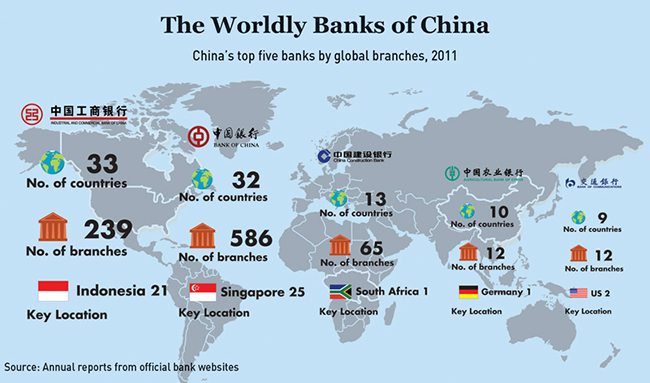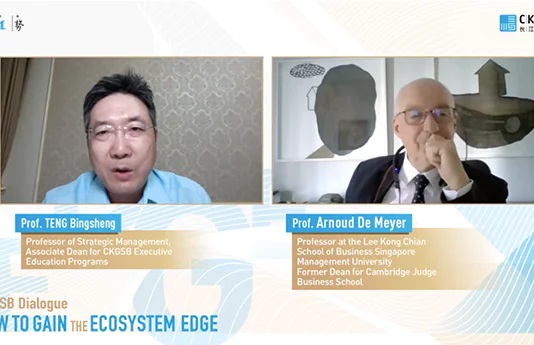
Chinese banks employ various strategies as they steadily march into international markets
On July 6th 2012, Industrial and Commercial Bank of China (ICBC), the world’s largest bank by market value, became a controlling shareholder in The Bank of East Asia’s US subsidiary after receiving final approval from American regulators to purchase 80% of the bank’s equity. This marked a milestone for the Chinese banking industry, and ICBC became the first Chinese financial institution to assume control of any US bank.
The deal was agreed upon more than two years ago, and despite its small size in dollar terms, the Chinese bank had to clear a lengthy 18-month approval process.
The ICBC acquisition, along with similar purchases and investments made by Chinese banks into offshore financial markets in recent years, represents the latest push in China’s ‘going global’ strategy. Chinese businesses have been successful in expanding into underdeveloped markets, in large part due to reduced competition from Western brands and a higher growth potential. Chinese businesses, especially those engaged in petroleum and construction engineering industries, are in great multitude overseas and require enormous credit lines to finance day-to-day operations.
In practice, Chinese banks provide a financial support network for Chinese businesses as they move into overseas markets, such as the Middle East, Africa and Latin America. Therefore, many Chinese lenders are, for the time being, primarily focused on commercial banking, and are not yet prepared to offer asset management and investment banking services. “We look to target regions that have a significant number of Chinese businesses in operation already, which allows us to play the critical role of financial intermediary,” Chief Executive of ICBC Middle East Tian Zhiping told the Financial Times in December 2012.
The expansion of Chinese banks into offshore markets represents a twofold triumph for Beijing officials. The first—and more obvious—meaning is that China’s central bank will have more influence on the global stage. As more countries begin using the renminbi to settle international payments, the yuan’s role in offshore financial markets will create additional leverage for the Chinese government in dealing with the World Trade Organization (WTO) and International Monetary Fund (IMF).
The second, and arguably more important inference, is that the expansion of Chinese businesses into international waters has reached critical mass. Chinese businesses have been investing heavily into R&D, management and branding capabilities. A recent Millward Brown analysis highlighted the growing success of Chinese businesses in foreign markets, and in 2012 Lenovo became the largest PC maker by volume, with overseas revenues accounting for 58% of total company revenue. These businesses want a streamlined financial system that allows an easy transfer of money between the mainland and offshore, and Chinese banks are better equipped to provide this service.
Chinese banks are extending their services in a variety of ways by taking advantage of their relative isolation from financial mayhem in the West. Acquisitions and equity investments by Chinese banks in major overseas financial institutions come at a time when mature US and European banks are struggling to manage risk and rebuild portfolios in the lingering aftermath of the 2008 financial crisis and Eurozone debt crisis. Declining bankruptcy and asset prices for offshore financial institutions are providing more choices for M&A deals by Chinese banks, and many countries are lowering market entry barriers to encourage financial investment.
For example, ICBC upped its original 20% stake in Standard Chartered Bank by $600 million in 2011 to acquire retail branches in Argentina after a meeting in Buenos Aires, according to a Wall Street Journal report. In a related move, the Bank of Portugal approved the opening of Bank of China’s (BoC) first Portugal branch, set for March, in January 2010, according to the Portugal Economy Probe, a non-profit economic news monitor.
“China has a huge volume of foreign currency reserves, and many Chinese businesses were not negatively affected by the financial crisis. State-owned enterprises are looking to invest abroad because the domestic market is over-invested, and Chinese banks help them do this,” says Zhou Shaojie, Associate Professor at Tsinghua University School of Public Policy and Management. “China needs to enhance its financial service offerings in offshore markets such as the United States.”
China’s need to expand in the US is obvious in its impressive increase in direct investment in the country. According to the Heritage Foundation’s research on China’s global investment activity, investment in the US jumped up by more than 41% year-on-year, reaching $54.2 billion in 2012, and soon to follow suit was ICBC, China’s largest bank, with its US bank acquisition.
China’s ‘Big Four’ state-owned banks are being encouraged to expand their overseas financial profiles in order to provide financial services for major Chinese business interests operating in foreign markets.
China’s top four lenders remain dependent on domestic financial operations for a majority of their annual revenue. Current overseas operations by major Chinese banks account for less than 10% of their total assets, according to a 2012 Standard & Poor’s report.
Despite a heavy reliance on domestic financial services, Chinese banks completed a total of 38 overseas M&A deals between 2002 and 2011, for a total value of $20.24 billion, according to financial services firm Deloitte.
“While banks will benefit from greater geographic diversity, rapid overseas expansion could test their operation and risk management capacity,” said Standard & Poor’s credit analyst Ryan Tsang in a July 2012 press release.
Strategic Overseas Expansion
ICBC has proven to be the most aggressive Chinese bank in overseas markets, setting up 239 subsidiaries and branch offices in 31 different countries and regions worldwide, according the company’s website. ICBC’s first majority equity purchase of an overseas bank was of Indonesia’s Bank of Halim in 2006. The Chinese bank would then go on to purchase majority and minority interests in seven foreign financial institutions between 2007 and 2012. In addition, the board of directors of ICBC announced in November 2012 that the bank had received regulatory approval to open branches in the Middle Eastern markets of Kuwait and Saudi Arabia, the Arab world’s largest economy and primary source of oil for Asia.
ICBC is not alone in its expansion. Agricultural Bank of China has opened branch offices in New York, Hong Kong, Seoul and Singapore.
By the end of 2010, Bank of China had overseas assets totaling $351.6 billion, according to internal bank records. Xiao Gang, chairman of the board of directors of Bank of China, published a letter to shareholders in July 2012, explaining why the bank must go global:
“There is good reason to believe that the Chinese economy has reached a point where its status as the biggest country will lead it to become the biggest in outbound direct investment. This new model not only requires Chinese enterprises to expand their global businesses, but also China’s banking sector to accelerate its internationalization,” Xiao wrote.
Although many Chinese bank executives are optimistic about entering new markets, others urge caution. During his final news conference as Chairman of China Construction Bank in 2011, Guo Shuqing, China’s new securities chief, called for due diligence in examining cross-border M&A. “It might seem a good deal. But it wouldn’t necessarily suit our development strategy,” he said. That strategy was set aside as ICBC acquired the Bank of East Asia, US branch, departing from a formula of serving Chinese clients in underdeveloped markets. China Construction Bank has taken part in some pretty weighty M&A deals in the past seven years. In 2006, the bank purchased 100% equity of the wholly owned Asia subsidiary of Bank of America, and then took over AIG affiliate AIG Finance (Hong Kong) in 2009.

Go Global, Serve Local
Generally speaking, the international arms of Chinese banks and financial institutions lag behind the operational and managerial capacities of more established multinational banks, and often lack the prerequisite language skills and knowledge of local culture and regulations necessary to compete for local clients.
“Chinese banks find it very hard to do business with local [non-Chinese] customers. They dream of serving local clients but are forced to follow preexisting clients as they move into international markets,” says Liu Jing, Associate Dean at the Cheung Kong Graduate School of Business.
Liu’s comments touch on why Chinese businesses abroad remain the focus of Chinese banks. Beijing is active in financing infrastructure projects across the developing world, where Western financial institutions control a smaller share of the market and the potential for growth is higher.
Over the long term, Chinese banks active in markets such as the Middle East up the volume of RMB cross-border payments. RMB-based transactions are a key part of the central government’s agenda for internationalizing the RMB and strengthening the central bank, but it will have to meet the IMF’s requirements first.
RMB and the IMF
In 2009, People’s Bank of China, the country’s central bank, began loosening currency controls by passing “Administrative Measures for Pilot Implementation for RMB Settlement in Cross-border Trade”. This allowed companies on the Chinese mainland to use the RMB in cross-border transactions. By 2011, cross-border RMB transactions were recorded in 181 countries and regions, and cross-border RMB settlements reached RMB 2.5 trillion, a growth rate of 394% over the same period in 2010, based on Deloitte data. According to financial consultancy Swift, more than 900 financial institutions in over 70 countries are already doing business in RMB.
Previous Chinese president Hu Jintao described the current US dollar-led currency system as “a product of the past,” and summarized China’s recent moves at “internationalizing” the renminbi in a written interview with the Washington Post and Wall Street Journal in 2011. But it is unlikely that the RMB will supplant the US dollar as the world’s reserve currency.
“You only have one real international currency, and that’s the US dollar. The United States has what I call ‘the ability to print out money and have everyone take it.’ This financial benefit makes it very desirable to have an international currency,” says Yukon Huang, a Senior Associate in the Carnegie Asia Program and World Bank’s former Country Director for China.
There are numerous benefits to having an international reserve currency. Domestic exporters have lower transaction costs in overseas markets, higher levels of business for financial institutions, seignorage and political power.
Beijing will likely adopt a more pragmatic approach by lobbying the IMF to support the use of the renminbi, rather than push for an international alternative to the dollar or euro.
“Beijing wants the RMB to grow to become part of a ‘basket of currencies’ held by the IMF during the next five to 10 years,” says Eswar Prasad, a senior fellow at the Peterson Institute for International Economics.
The Special Drawing Right (SDR) currency basket held by the IMF is an international reserve asset used by the fund to act as a potential claim on IMF member currencies, and does not function as a currency itself. The current SDR basket is made up of four currencies—the euro, yen, dollar and pound—but Beijing officials have indicated that the renminbi should be included in the basket.
Current regulations require that SDR basket currencies have to be issued by a major export country, and the currency must be considered “freely usable.” A currency is generally considered “freely usable” once it is used as a unit of account, such as corporate invoices, as a medium of exchange, as in settling cross-border transactions, and as a store of value, including deposits and reserve currency. However, China does not predict the renminbi will reach this threshold before 2015, despite having US support to introduce the renminbi into the IMF basket.
The RMB ranked 21 in world currencies as of June 2011, with only a 0.24% share in total payments, compared to China’s share in global exports at 10.4% in 2011, according to World Trade Organization statistics. China’s currency can’t go into the IMF basket until the renminbi’s share in total international payments approaches its portion of global exports.
Chinese banks will continue to pair with Chinese businesses as they expand into new offshore markets. This will promote payments in RMB and increase the level of RMB currency reserves held by foreign countries. Western banks likely won’t compete directly with Chinese financial institutions as they begin to explore less developed regions and the Middle East. To maintain expansion, Chinese banks will have to begin offering more sophisticated financial products as they adapt to local clients’ needs and expectations.



















